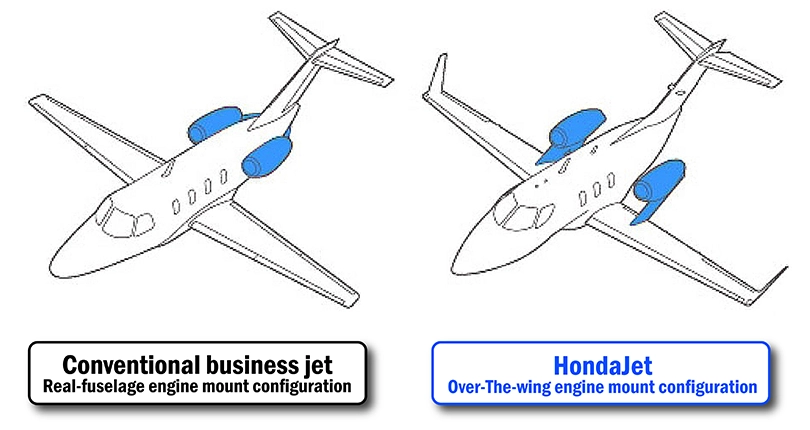POINTWhat you can learn from this article
- Honda Aircraft Company is Honda’s aviation business subsidiary developing, manufacturing and selling light business jets
- HondaJet features groundbreaking Over-The-Wing Engine Mount (OTWEM) technology
- Unique engine placement dramatically improves comfort, speed, cabin space and fuel economy
Honda Aircraft Company: Honda’s aviation business company
HondaJet is the very light jet developed, manufactured, sold, and serviced by Honda Aircraft Company (HACI), Honda’s aviation business company.
 HondaJet, the very light jet that shocked the aviation industry
HondaJet, the very light jet that shocked the aviation industry
Light business jets are widely used by business owners for travel, business trips, shared ownership, and charter flight services. In recent years, the charter business has been trending in the aviation industry, and the number of users is increasing yearly.
HondaJet’s most outstanding feature is the placement of engines over the wings, a complete departure from conventional wisdom. By moving the engines over the wings, not only is the interior more comfortable and spacious, but aerodynamic drag is suppressed, and higher speed and fuel economy is achieved, making the HondaJet an aircraft of functional beauty.
POINTHondaJet features
- Innovative light jet with engines mounted over the wing
- Comfortable and spacious interior, while achieving high speeds and fuel economy
HACI was established in 2006. Located in North Carolina, USA, the R&D Center, headquarters, production plant, and customer service are all situated on the same site. HondaJet development, manufacturing, sales, and customer service are supported by approximately 1,000 employees (as of 2024) from over 40 countries.
Honda Aircraft Company history
| 1986 | Honda begins basic research on aircraft |
|---|---|
| 1993 | First flight of experimental aircraft was achieved |
| 1997 | Developed a revolutionary concept of mounting the engines on top of the main wings |
| 2003 | Experimental HondaJet successfully completed first flight |
| 2005 | World premiere of the HondaJet experimental aircraft |
| 2006 | Honda Aircraft Company established to commercialize the HondaJet |
| 2015 | Obtained type certification and successfully delivered the first aircraft Began production and sales |
| 2018 | Began delivery in Japan(https://global.honda/en/newsroom/news/2018/c181220eng.html) Achieved world's No. 1 small business jet in terms of deliveries |
| 2022 | 2022 Hideto Yamasaki appointed as the company’s second president and CEO |
| 2023 | Reveal name and key milestones of the New Light Jet : HondaJet Echelon |
Entering the aviation business with a team of 40 elite staff and groundbreaking technology
Honda began basic research on aircraft in 1986, around 40 years ago. The research project on airframe and engine technology began at the newly established Fundamental Technology Research Center in Wako, Saitama in Japan.
The Center was an advanced research institute that aimed to develop new areas of technology for the 21st century, with aircraft as one of its research themes. The project was led by Michimasa Fujino, HACI’s first president. The goal of the aircraft project was to develop Honda’s own light aircraft that would combine the most advanced aircraft technologies. For Honda, which had no previous aircraft technology, this was a huge challenge.
After the project was launched, Fujino promptly moved to the United States. He spent his time building propeller airplanes by day, and at night studied the world’s most advanced aeronautical technologies. As Honda was a newcomer to the aviation industry, the goal of creating overwhelming value unbound by conventional wisdom was shared by the team from the basic research stage, and every aspect was well considered.
Aircraft design began in earnest in 1987. After conducting joint research with Mississippi State University’s Raspet Aeronautical Laboratory, Honda completed its first six-seat experimental light jet, the MH-02, in 1993. Another four years passed before the idea of mounting the engines over the wings, a feature that makes the HondaJet unique, was conceived.
 The development team conducting basic research with the experimental model MH-01. (Fujino ; 3rd from the right, in the back)
The development team conducting basic research with the experimental model MH-01. (Fujino ; 3rd from the right, in the back)
Engines of light business jets are generally positioned at the rear of the fuselage on each side. Placing engines on the upper surface of the main wings would increase aerodynamic drag and reduce lift, resulting in lower speed and fuel efficiency, which was unthinkable in the aviation industry at the time.
If an aerodynamic design could be realized that reduces wave drag at high speed, would there be a way to place the engine on top of the main wings without increasing drag?
This idea, implemented through trial and error by Fujino’s development team of about 40 people, was commended by the aviation industry as “an important discovery in aircraft design.”
 Conventional engine placement (left) and HondaJet engine placement (right)
Conventional engine placement (left) and HondaJet engine placement (right)
The first two years were spent conducting proof-of-concept simulations and wind tunnel tests at Boeing facilities, and the actual design began in 1999. After completing fuselage assembly, strength testing, and system functionality testing, flight testing began in 2003. In December of the same year, the first flight was successfully completed with an airframe and engine package that was manufactured in-house – a rare milestone.

 Aircraft company employees were astonished at the way the HondaJet passed flight tests without issue.
Aircraft company employees were astonished at the way the HondaJet passed flight tests without issue.
Although the success of the HondaJet’s flight tests demonstrated its performance and potential as a product, the view within the company was that commercialization would be difficult. There was no precedent for an entry into the aviation industry, considered highly specialized, from another industry. There was the strong possibility that the HondaJet research and development project would come to an end along with the flight testing of the proof-of-concept (POC) aircraft.
Fujino implored Honda management for one last opportunity to showcase HondaJet at an air show, and the 2005 EAA AirVenture Oshkosh, one of the world’s largest air shows, became the last hope for the HondaJet.
On the day of the show, the HondaJet landed on the runway and moved to the tarmac, where it was surrounded by more than 1,000 aviation fans, all of whom commended the beauty of the HondaJet, unlike anything they had ever seen before.
 The first public appearance at EAA AirVenture Oshkosh in 2005.
The first public appearance at EAA AirVenture Oshkosh in 2005.
Commercialization achieved after submitting 2.4 million pages of documentation for type certification
After its sensational debut at Oshkosh, the company’s view toward commercialization began to change, as customers even began to send in checks for the HondaJet. After numerous negotiations, Takeo Fukui, then president of Honda, green-lighted commercialization of the HondaJet in March 2006.
In the same year, the aircraft company’s headquarters was established in the United States, where demand for business jets was greatest and the flow of commercialization could be smoothly facilitated, and Fujino was appointed as its first president. From here, a new struggle toward commercialization began.
Obtaining type certification required for commercialization took an unimaginable amount of effort. After completing the design review to confirm that there were no problems with the design, durability of each component was checked, followed by durability of the aircraft itself, a test plane was built and tested many times to ensure that there would be no issues flying in cold weather or at high altitude, and the results of all these tests were documented and submitted to the Federal Aviation Administration (FAA) for various approvals.
HondaJet obtained its type certification in 2015. During this period, HACI submitted 2.4 million pages of documents to the FAA, which, counting in A4 sheets of paper, would be 240 meters high and weigh 175.2 tons. After overcoming numerous hardships, HondaJet was successfully commercialized, three decades after the project was launched.
In 2022, HACI’s first president and CEO, Fujino, retired and Hideto Yamasaki assumed the position. In 2024, HACI reached a major milestone when Fujino became the first Japanese to receive the American Institute of Aeronautics and Astronautics (AIAA) Daniel Guggenheim Medal. Since, 2015 HondaJet has been delivered to North America, Europe, Latin America, Southeast Asia, China, the Middle East, India, and Japan, with a total of 250 aircraft delivered (as of February 2024). No other aircraft with Over-The-Wing Engine Mount technology has been commercialized and operated as of 2024, thus continuing to prove the high level of HACI’s technological capabilities.
 2023 EAA AirVenture Oshkosh. Honda’s unique exhibits, including cars and motorcycles, were well received by visitors.
2023 EAA AirVenture Oshkosh. Honda’s unique exhibits, including cars and motorcycles, were well received by visitors.
HondaJet history
| Model | HondaJet Echelon *upcoming model |
|---|---|
| Dates | 2026 First flight planned 2028 Type certification planned |
| Features |
20% more fuel efficient than competing light jets*1 and 40%*2 more fuel efficient than higher midsize category jets*3, making it the world’s first light jet capable of nonstop transcontinental flight across the United States *1 Twin-engine aircraft with a maximum takeoff weight of 12,500 pounds or more but less than 20,000 pounds. (One category above the HondaJet Elite II (very light jet)) *2 Comparison based on flight distance across the U.S. continent (between New York and Los Angeles) *3 Twin-engine aircraft with a maximum takeoff weight of 20,000 pounds or more but less than 35,000 pounds. |
| Model | HondaJet Elite II |
| Date | October 18, 2022 |
| Features |
Expanded range thanks to improved fuel tank design Optimized takeoff and landing field performance including airfields with short runways, due to ground spoiler placement to increase drag |
| Model | HondaJet Elite S |
| Date | May 27, 2021 |
| Features |
Range extended to 222km Equipped with Advanced Steering Augmentation System (ASAS) to enhance safety by supporting the pilot in specific weather conditions |
| Model | HondaJet Elite |
| Date | May 27, 2018 |
| Features |
Range extended by approximately 17% (396km) compared to the original HondaJet Improved quietness through the adoption of a new inlet structure that reduces engine noise |
| Model | HondaJet |
| Date | December 21, 2013 |
| Features | Engine placement on the main wings dramatically improves comfort, speed, cabin space and fuel economy |
* Dates are in Japan Standard Time






